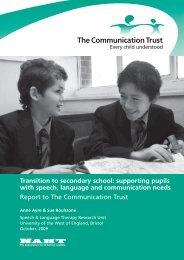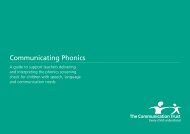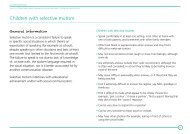A Generation Adrift - The Communication Trust
A Generation Adrift - The Communication Trust
A Generation Adrift - The Communication Trust
Create successful ePaper yourself
Turn your PDF publications into a flip-book with our unique Google optimized e-Paper software.
Workforce development<br />
Children with SLCN need support at<br />
all levels, in the classroom as well as<br />
by specialists. Children are very clear<br />
about what works for them – other<br />
people’s behaviour and understanding<br />
is paramount. 59 However, there’s a<br />
need for workforce development,<br />
both in initial training and as continual<br />
professional development (CPD) as<br />
children with SLCN can and do fall<br />
through the gaps in professional<br />
knowledge and in the system.<br />
<strong>The</strong>re remain huge challenges for<br />
teachers and other practitioners in<br />
effectively identifying and supporting<br />
children and young people with SLCN.<br />
Particular challenges for teachers<br />
are in changing classroom practice,<br />
with research showing the need for<br />
systematic professional development.<br />
Teachers themselves express a lack<br />
of confidence in knowing how to<br />
support children and young people<br />
with SLCN. 60<br />
Often, lessons are dominated by<br />
teacher talk which rarely improves<br />
spoken language or enhances<br />
learning. 61 Four decades ago, the<br />
Bullock Report 62 calculated that<br />
pupils had on average a 20 second<br />
window to each contribute verbally in<br />
a 45-minute lesson. Recent research<br />
suggests things have not greatly<br />
improved. One survey of secondary<br />
schools in an inner city identified<br />
adults talking for up to 90% of the<br />
time 63 and more recent research<br />
put the average length of a pupil’s<br />
contribution to class discussion at just<br />
four words. 64 Research has indicated<br />
that variations in the quality and<br />
quantity of the language that children<br />
experience in their homes 65 and<br />
educational environments 66 strongly<br />
influence individual differences in the<br />
rate of children’s language growth<br />
and later language outcomes.<br />
In a recent report, Ofsted found<br />
new teachers didn’t have a solid<br />
knowledge of language development<br />
and struggled to adapt their own<br />
language for those children with<br />
poor language skills. <strong>The</strong> need for<br />
high quality training during initial<br />
teacher education in these areas was<br />
highlighted as important in order to<br />
support teachers to do this. 67<br />
Case study<br />
<strong>The</strong> <strong>Communication</strong> <strong>Trust</strong> has<br />
developed Let’s Talk About<br />
It, an information booklet<br />
available to all initial teacher<br />
trainees, available from www.<br />
thecommunicationtrust.<br />
org.uk/resources. <strong>The</strong> <strong>Trust</strong><br />
has worked with a group of<br />
universities to embed speech<br />
and language information into<br />
initial teacher training and is<br />
currently working on a project<br />
with a university and a primary<br />
school within a co-operative<br />
learning trust, using a targeted<br />
intervention programme to<br />
embed changes in practice of<br />
initial teacher trainees.<br />
Services and support<br />
Children and young people with<br />
SLCN not only fall through the gaps<br />
in professional expertise but also in<br />
how support is paid for and delivered.<br />
Prevention and early identification<br />
need as much consideration as<br />
specialist services for those children<br />
and young people with identified<br />
SLCN. Health and education need<br />
to work together to design and<br />
commission needs-led local services<br />
considering universal as well as<br />
targeted and specialist approaches.<br />
However, there remain challenges<br />
in joint planning locally for children<br />
and young people with SLCN due to<br />
increasing evidence of significant cuts<br />
to front line speech and language<br />
therapy services 68 and to the<br />
specialist advisory teaching services. 69<br />
A <strong>Generation</strong> <strong>Adrift</strong> 17

















